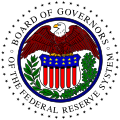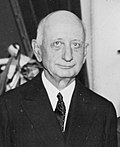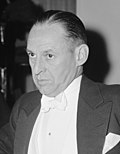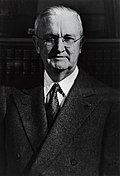Top Qs
Timeline
Chat
Perspective
Chair of the Federal Reserve
Head of the United States Federal Reserve System From Wikipedia, the free encyclopedia
Remove ads
The chairman of the Board of Governors of the Federal Reserve System is the head of the Federal Reserve, and is the active executive officer of the Board of Governors of the Federal Reserve System. The chairman presides at meetings of the Board.[2]
The chairman serves a four-year term after being nominated by the president of the United States and confirmed by the United States Senate; the officeholder serves concurrently as a member of the Board of Governors. The chairman may serve multiple terms, subject to re-nomination and confirmation each time; William McChesney Martin (1951–1970) was the longest serving chair, with Alan Greenspan (1987–2006) a close second.
Jerome Powell was sworn in as chairman on February 5, 2018.[3][4] He had been first nominated to the position by President Donald Trump on November 2, 2017,[5] and confirmed by the Senate. He was nominated to a second term by President Joe Biden, confirmed by the Senate, and sworn in on May 23, 2022.[6][7]
Remove ads
Appointment process

As stipulated by the Banking Act of 1935, the chairman is chosen by the president from among the sitting governors to serve four-year terms with the advice and consent of the Senate.[2][8][9][10] The Senate Committee responsible for vetting a Federal Reserve chair nominee is the Senate Committee on Banking.
Remove ads
Duties of the Fed chairman
By law, at meetings of the Board the chairman presides; in his or her absence, the vice chairman presides. In the absence of the chairman and the vice chairman, the Board shall elect a member to act as chairman pro tempore.[11]
Under the chairman's leadership, the Board's responsibilities include analysis of domestic and international financial and economic developments. The board also supervises and regulates the Federal Reserve Banks, exercises responsibility in the nation's payments system, and administers consumer credit protection laws.[12]
By custom, the chairman also chairs the Federal Open Market Committee (FOMC), which directs short-term U.S. monetary policy. Although the statute and rules of the FOMC allow it to elect any member as its chair,[13] it has always chosen the chairman of the Board in practice.
By law, the chairman reports twice a year to Congress on the Federal Reserve's monetary policy objectives. He or she also testifies before Congress on numerous other financial issues and meets periodically with the treasury secretary, who is a member of the president's Cabinet.[14]
Remove ads
Conflict of interest law
The law applicable to the chair and all other members of the board provides (in part):
No member of the Board of Governors of the Federal Reserve System shall be an officer or director of any bank, banking institution, trust company, or Federal Reserve bank or hold stock in any bank, banking institution, or trust company; and before entering upon his duties as a member of the Board of Governors of the Federal Reserve System he shall certify under oath that he has complied with this requirement, and such certification shall be filed with the secretary of the Board.[15]
Salary
Chair of the Federal Reserve is a Level I position in the Executive Schedule,[1] thus earning the salary for that level (US$246,400, as of April 2024).[16]
List of Fed chairs
Summarize
Perspective
The following is a list of past and present chairs of the Board of Governors of the Federal Reserve System. A chair serves for a four-year term after appointment, but may be reappointed for several further four-year terms. Since the Federal Reserve was established in 1914, the following people have served as chair.[a][17][18]
Remove ads
See also
Notes
- The position was established as Governor of the Federal Reserve Board on December 23, 1913; thereafter became Chairman of the Board of Governors of the Federal Reserve System on August 23, 1935; and re-aligned to be gender-neutral after Yellen became the first female officeholder on February 3, 2014.
- The start date given here for each officeholder is the day they took the oath of office, and the end date is the day of their term expiration, resignation, or retirement.
- A fixed term with reappointment for the Chair, then known as Governor, was not added to the Federal Reserve Act until the Banking Act of 1935 (P.L. 74-305, 49 Stat. 684).
- Upon enactment of the Federal Reserve Act on December 23, 1913, the United States secretary of the treasury became ex officio chairman of the Federal Reserve Board and a member of the Reserve Bank Organization Committee (RBOC); all appointed officeholders, from William Gibbs McAdoo to Henry Morgenthau Jr., concurrently served in the position until the Banking Act of 1935 was signed into law on Aug. 23, 1935, which became effective on Feb. 1, 1936. That legislation ceased ex-officio membership, and the active executive officer (previously called the governor of the Federal Reserve Board) became the chairman of the Board of Governors. For purposes of this list, the governor has been perceived as the head of the Federal Reserve System since the establishment of that position on August 10, 1914, because the treasury secretary is a political appointee who can be dismissed by the president of the United States at any time, whereas the Federal Reserve has been created as an independent government agency.
Remove ads
References
Further reading
External links
Wikiwand - on
Seamless Wikipedia browsing. On steroids.
Remove ads




















